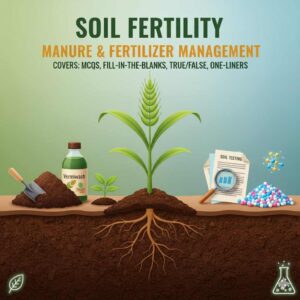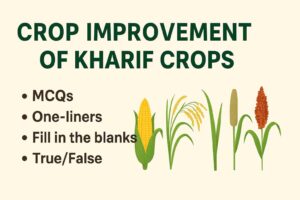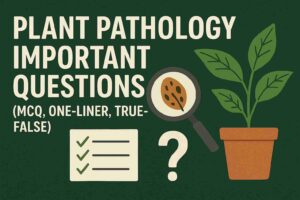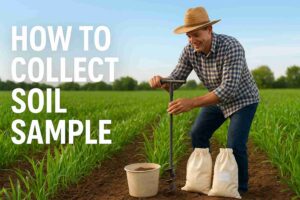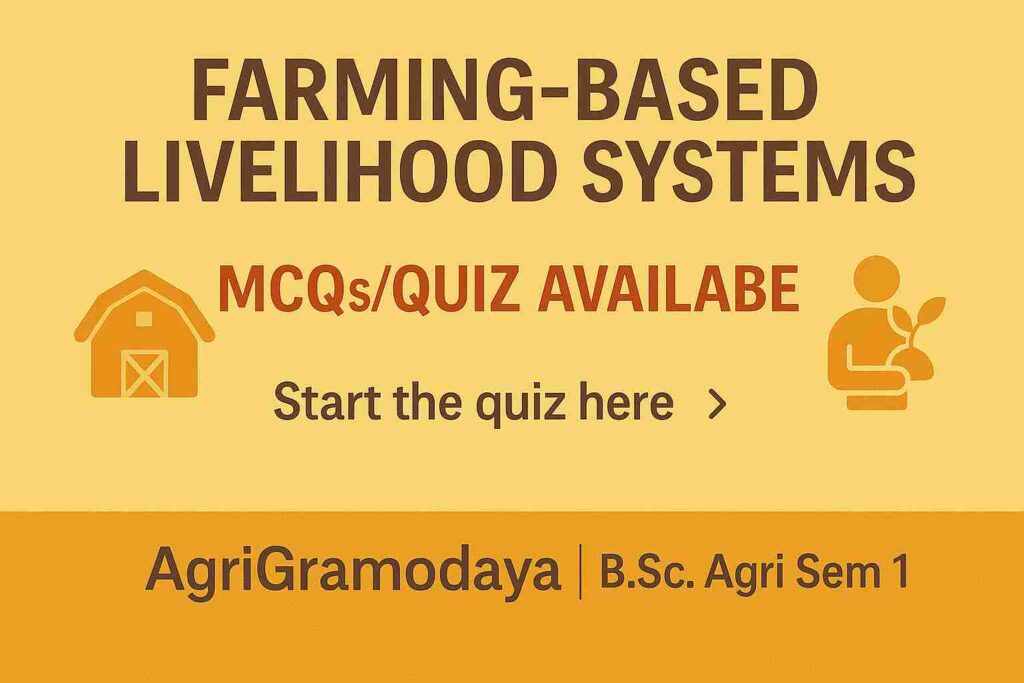
Introduction of Farming Based Livelihood system MCQs
Are you a BSc Agriculture student struggling to understand complex topics like livelihood, farming systems, and enterprise integration? Don’t worry — this blog is your one-stop solution!
In today’s rapidly changing agricultural world, understanding Farming-Based Livelihood Systems is not just important for exams but also for real-life applications on the farm. Whether it’s ICAR models, NABARD schemes, integrated farming, or circular economy—everything revolves around sustainable livelihoods.
In this blog, we bring you the 30 most important, evergreen Farming Based Livelihood system MCQs that are directly based on the latest 6th Dean Committee Syllabus for BSc Agri 1st semester. Each question comes with a clear explanation that helps you understand the concept, not just memorize the answer.
✅ Perfect for semester exams, competitive tests, and self-learning.
✅ Questions include theory, logic, real-life case-based, and tech-based MCQs.
✅ Ideal for smart revision, agri interviews, and future agri-entrepreneurs!
Farming Based Livelihood system mcqs PDF Download
Q1. Which state has the highest contribution to food grain production in India?
a) Punjab
b) Uttar Pradesh
c) Maharashtra
d) Madhya Pradesh
📝 Additional Information
Uttar Pradesh contributes the highest share to India’s food grain production due to
Fertile Indo-Gangetic plains
High wheat & rice productivity
An extensive irrigation system
👉 Punjab is high in productivity, but UP leads in total volume.
Q2. As per recent surveys, the average monthly income of an Indian agricultural household is approximately
a) ₹4,500
b) ₹6,400
c) ₹10,200
d) ₹12,500
📝 Additional Information
According to the NSSO Situation Assessment Survey (2021), the average monthly income of a farm household is approx ₹10,218.
This includes:
Crop income
Livestock income
Wages and non-farm earnings
👉 Farmer income is a key metric for livelihood status assessment.
Q3. Which of the following is the most suitable indicator for assessing rural livelihood sustainability?
a) TV ownership
b) Soil health index
c) Diversified income sources
d) Mobile recharge spending
📝 Additional Information
Sustainable livelihoods depend on multiple income streams like crops, dairy, poultry, or non-farm work.
The more diversity, the better the resilience against
Crop failure
Market shocks
Climate change
👉 TV or mobile spend is not a strong livelihood sustainability metric.
Q4. Which of the following best defines a livelihood?
a) Only earning money from agriculture
b) A job done by rural people
c) Means of securing the basic needs of life
d) Farming activity is done seasonally
📝 Additional Information
A livelihood includes:
Activities
Assets
Access to resources
…through which people secure food, shelter, clothing, and income.
👉 It is not limited to farming and includes non-farm jobs, services, and enterprises too.
Q5. Which livelihood pattern is most common in urban areas compared to rural areas?
a) Integrated farming systems
b) Daily wage of agricultural labour
c) Self-employment through street vending
d) Crop-livestock-horticulture models
📝 Additional Information
Urban livelihoods are dominated by:
Street vending, small shops
Daily wage jobs in construction and transport
Delivery services, micro-businesses
In contrast, rural livelihoods are mostly based on agriculture, livestock, and seasonal migration.
Q.6 What is the main goal of an agricultural livelihood system (ALS)?
a) To maximize crop yield only
b) To enhance rural internet connectivity
c) To integrate farm activities for sustainable income
d) To promote foreign trade of farm products
📝 Additional Information
ALS is a holistic approach that combines:
Crop cultivation
Animal husbandry
Non-farm enterprises
…to generate stable income for farm families.
👉 Its focus is long-term sustainability, food security & income security.
Q.7 Which of the following best explains the “farming systems approach”?
a) Using only chemical fertilizers to increase yield
b) Focusing only on single-season crops
c) Integration of crops, animals, and other enterprises
d) Shifting from manual labor to machines only
📝 Additional Information
The farming system approach involves:
Combining multiple components like crops + livestock + poultry + agroforestry
Efficient use of resources, labor, and time
Reducing risk and increasing income sources
👉 It’s the base of sustainable rural livelihood.
Q.8 Which farming system is most prevalent in India’s rainfed regions?
a) Dairy-poultry integrated farming
b) Crop-livestock mixed farming
c) Aquaculture and duck farming
d) Sugarcane-based commercial farming
📝 Additional Information
In rainfed/dryland regions, irrigation is limited, so farmers rely on:
Rainfed crops (millets, pulses)
Goatry, poultry, or cattle for additional income
This reduces risk and utilizes available resources smartly.
👉 This is a practical and adaptive system for resource-poor areas.
Q.9 Which of the following is a key difference between traditional and modern farming systems?
a) Traditional uses high-tech machinery
b) Modern depends only on animals
c) Traditional focuses on sustainability, modern on market-oriented production
d) There is no difference
📝 Additional Information
Traditional farming = low input, family labour, natural methods, focus on self-reliance & soil health
Modern farming is market-driven and uses chemicals, hybrid seeds, and mechanisation
👉 Both have pros and cons, and modern systems often lack ecological balance.
Q.10 Which farming system is commonly found in the states of Kerala and Tamil Nadu?
a) Wheat-based mono cropping
b) Agro-forestry with coconut and spices
c) Intensive piggery units
d) Rice-fish-duck mixed farming
📝 Additional Information
In Kerala and Tamil Nadu:
Coconut, areca nut, banana, pepper grow well
Often combined with trees and spices → Agroforestry
Supports diverse income & environmental protection
👉 Such systems support both economic & ecological sustainability.
Q.11 Which integrated farming model combines fish production with birds to utilize waste efficiently?
a) Dairy-poultry model
b) Poultry-cum-fish model
c) Agroforestry-fish model
d) Goatry-based orchard
📝 Additional Information
In a poultry-cum-fish system, the droppings of poultry birds directly fertilize the fish pond, promoting plankton growth which is fish feed.
This model:
Saves cost on fish feed
Increases resource recycling
Is eco-friendly and income-efficient
❌ Dairy model doesn’t directly support fish
❌ Agroforestry-fish is less connected
❌ Goatry-based orchard is a soil-fodder link, not aquaculture
Q.12 Which enterprise is best suited for small and marginal farmers to generate quick income?
a) Agro-processing unit
b) Dairy with 50+ animals
c) Backyard poultry
d) Commercial orchard
📝 Additional Information
Why backyard poultry?
Because:
Less space, low investment
Eggs/meat start giving returns within weeks
Feed can be managed locally
❌ Agro-processing needs capital
❌ Dairy with 50+ is too large-scale
❌ Orchards need years to mature
👉 Backyard poultry = fast cash flow + low risk for rural families.
Q.13 Which cropping system refers to growing more than one crop on the same field in a year?
a) Intercropping
b) Crop rotation
c) Mixed cropping
d) Multiple cropping
📝 Additional Information
Multiple cropping = growing 2 or more crops in a year (e.g., wheat in rabi + rice in kharif)
It helps in maximum land use & income
Other terms:
🔹 Intercropping = two crops at same time, same field
🔹 Crop rotation = different crops in different seasons, but in sequence
🔹 Mixed cropping = sowing seeds together without pattern (e.g., wheat + mustard)
👉 Multiple cropping boosts land productivity across seasons.
Q.14 Which is a major horticulture-based livelihood crop in tribal and hilly areas of India?
a) Maize
b) Ginger
c) Mustard
d) Wheat
📝 Additional Information
Ginger is:
Grown in North-East, Odisha, Jharkhand etc.
Gives good market value and thrives in slope conditions
Requires less water than many field crops
❌ Maize and wheat = field crops
❌ Mustard = rabi oilseed crop
👉 Ginger = smart choice for tribal income & small landholders.
Q.15 What is the main benefit of integrating enterprises like piggery and fishery?
a) Double use of drinking water
b) Pigs eat fish
c) Better feed efficiency and waste utilization
d) Fish help pigs stay clean
📝 Additional Information
In piggery-cum-fish systems:
Pig waste is rich in nutrients → used as fish pond manure
Helps in plankton growth
Improves water body’s productivity
👉 This kind of integration supports zero-waste circular farming models
Q.16 Which of the following is a biological factor affecting integration of enterprises in farming systems?
a) Farmer’s education level
b) Agro-climatic zone
c) Availability of crop residues
d) Social customs of the village
📝 Additional Information
Biological factors are those that relate to natural resources or outputs, like:
Crop residues
Livestock dung
Aquatic weeds
These can be reused for other enterprises (e.g., dung → biogas, residues → livestock feed).
❌ Education, social customs = human or cultural factors
❌ Agro-climatic = environmental, not biological in this context
👉 Crop residues play a vital role in circular resource flow farming
Q.17 Which enterprise is best suited for eastern India’s wet and flood-prone zones?
a) Goatry
b) Aquaculture
c) Arhar cultivation
d) Mushroom farming
📝 Additional Information
In wetlands of Bihar, West Bengal, Assam, etc., standing water is a challenge.
Turning that into a livelihood opportunity via aquaculture (fish farming) is:
Environmentally suitable
Income-generating
Low maintenance if properly trained
👉 Other options don’t suit wetland conditions.
Q.18 Which of the following correctly defines a “value chain” in the context of farming-based livelihoods?
a) Selling produce directly to farmer groups
b) Process by which value is added to farm produce at each step from farm to market
c) Chain of command in agriculture departments
d) A system where middlemen fix the price of crops
📝 Additional Information
A value chain includes:
Post-harvest handling
Processing
Packaging
Marketing
Each step adds value and profit margin to the final product.
👉 For example, raw turmeric → boiled → dried → powdered → branded = value-added journey.
Q.19 Which agro-climatic zone is most suitable for dairy-based farming system in India?
a) Western Himalayan Region
b) Arid Western Plains
c) Upper Gangetic Plains
d) Coastal saline zone
📝 Additional Information
Upper Gangetic Plains (e.g., Uttar Pradesh, Bihar) offer:
Good fodder availability
Easy access to water
High milk consumption markets nearby
👉 Dairy thrives where feed, water, and market are easily accessible.
❌ Arid zones → lack water
❌ Coastal zones → saline water isn’t ideal for fodder crops
Upcoming agriculture exams 2025
Q.20 Which secondary enterprise has seen rapid growth among rural youth due to value addition opportunities?
a) Manual ploughing
b) Seed sowing by hand
c) Vermicomposting and organic input production
d) Bullock-cart transportation
📝 Additional Information
Today’s rural youth are exploring:
Vermicomposting units
Organic manure packing
Bio-pesticide production
👉 These micro-enterprises need low investment, offer branding potential, and tap into the growing organic farming market.
Other options are either outdated or low-value.
Q.21 Which organization has developed various commercial farming-based livelihood models across India through SHGs and rural youth?
a) ICAR
b) NABARD
c) Ministry of Education
d) NSDC
📝 Additional Information
NABARD (National Bank for Agriculture and Rural Development) works on:
Micro-enterprise promotion
SHG-led models
Credit-linked livelihood programs
👉 It supports dairy, poultry, vermicompost, mushroom, goatry, fishery etc., through rural finance + skill training.
❌ ICAR focuses on research
❌ NSDC = Skill development, not agri models
❌ Education Ministry = Not agri-livelihood centric
Q.22 ICAR’s “Integrated Farming System” (IFS) model primarily aims at:
a) Replacing crop production with animal farming
b) Increasing the number of labourers onthe farm
c) Reducing post-harvest loss
d) Enhancing income by integrating multiple farm activities
📝 Additional Information
ICAR promotes IFS models like:
Crop + Livestock + Horticulture
Fish + Poultry + Duck
Agroforestry with vegetables
👉 Main aim: Maximize returns, minimize risk and make farming sustainable for smallholders.
Q.23 Which of the following Central Government schemes promotes “value addition” and “marketing” support for farmer-producers?
a) PMAY
b) PM-KISAN
c) PM-FME
d) MG-NREGA
📝 Additional Information
PM-FME = Pradhan Mantri Formalization of Micro Food Enterprises
Focuses on:
Local food businesses
Support for branding, processing, packaging
Encourages “vocal for local” movement
👉 It directly promotes farm-based entrepreneurship
Q.24 Case: A tribal SHG in Jharkhand started lac cultivation with forest support and earned ₹30,000/season per member. Which type of livelihood is this?
a) Non-farm income
b) Allied enterprise model
c) Forest-based farming livelihood
d) Agro-processing
📝 Additional Information
This is a classic example of:
Using natural resources sustainably
Tribal women-led forest product enterprise (lac, tendu leaves, etc.)
Low investment, high return
👉 These models are promoted by NGOs and tribal development programs.
Q.25 Which of the following best describes the role of public-private partnership (PPP) in farming-based livelihoods?
a) Government buys all farm produce
b) Farmers lease land to companies permanently
c) Combining government schemes with private tech and market linkages
d) NGO volunteers working alone in rural areas
📝 Additional Information
Public-Private Partnerships (PPP) in agri livelihood promote:
Tech support (like digital platforms)
Market linkage (contract farming, e-mandi)
Policy + finance from government
👉 These models create holistic, scalable solutions for rural farmers.
Q.26 Which of the following is a major climatic risk that affects farming-based livelihoods across India?
a) Stable market prices
b) Timely monsoon
c) Unpredictable rainfall patterns
d) Government subsidies
📝 Additional Information
Rainfall variability leads to:
Crop failure
Fodder shortage
Water scarcity
👉 Unpredictable monsoons are the most serious climate-linked threat to rural income security.
Market prices and subsidies are economic risks — not direct climatic ones.
Q.27 Which practice is central to the idea of a “circular farming economy”?
a) Use of imported hybrid seeds
b) Maximizing chemical fertiliser use
c) Recycling waste and integrating the outputs of one enterprise into another
d) Exclusive focus on mono-cropping
📝 Additional Information
Circular farming = waste of one = input of another
Examples:
Cow dung → biogas + manure
Poultry droppings → fish pond nutrient
Crop residue → mushroom beds
👉 It saves resources and boosts farm efficiency and eco-sustainability.
Q.28 Which digital tool has recently helped farmers in market access and online produce selling?
a) Google Drive
b) Aarogya Setu
c) e-NAM portal
d) MS Word
📝 Additional Information
e-NAM = Electronic National Agricultural Market, launched by Govt of India.
It:
Connects farmers to buyers across states
Helps get better price discovery
Reduces role of middlemen
👉 It’s a game-changer in agri-marketing for rural producers.
Q.29 Which of the following modern lifestyle trends is shaping demand for new agri livelihood models?
a) Preference for synthetic food
b) Shift towards processed fast food
c) Increased demand for organic and healthy farm products
d) Dependence only on imported food
📝 Additional Information
Urban lifestyle is now more focused on:
Healthy eating
Chemical-free food
Farm-to-fork branding
👉 This shift is giving rise to:
Organic vegetable kits
Home-delivered farm produce startups
Direct farmer-to-customer brands
Q.30 How does digital literacy help rural youth in farming-based livelihood systems?
a) By helping them avoid farming work
b) By connecting them to global entertainment
c) By enabling online selling, learning, and enterprise setup
d) By stopping them from using local tools
📝 Additional Information
Digital literacy allows:
Online tutorials on farming methods
YouTube or WhatsApp marketing of produce
Govt scheme applications
GPS mapping for soil and water usage
👉 It makes youth confident entrepreneurs, not just traditional farmers.
Conclusion: Farming Based Livelihood system MCQs with Explanations for BSc Agriculture"
Farming is no longer just about growing crops—it’s about building a sustainable, profitable, and integrated livelihood system.
Through this MCQ blog, we’ve covered every major concept from your syllabus — from the basics of rural livelihoods to modern farming systems, value chains, government schemes, and digital trends shaping 21st-century agriculture.
✅ If you revise these 30 questions with their explanations, your fundamentals will be strong and exam-ready.
✅ Share this with your classmates — because agriculture ka future tabhi strong hoga jab students smart aur informed honge.
🔁 Want more MCQs like this on other subjects? Let us know in the comments or check out our next subject series.
📌 Stay connected with AgriGramodaya.com for student-friendly agri notes, updates, and digital farming content that truly makes a difference.
Click to Join Our Free WhatsApp Group and YouTube for Agriculture Updates!
Get daily updates, free study material, and the latest schemes, and connect with other agriculture students and farmers.
Download most common agricultural exams syllabus.
Latest Syllabus | Download Here |
IBPS Agriculture Filed Officer | |
NABARD GRADE A | |
Food Corporation of India (FCI) | |
RAEO | |
RHEO | |
Food Inspector | |
IFFCO AGT | |
MP PAT | |
UPSSSC AGTA |
Download other BSC agriculture subjects MCQs.
Latest post
ICAR JRF Agronomy: Decoding the 2024-2025 Papers & Cracking the IARI Code
ICAR JRF Agronomy 2 year paper analysis A high ICAR...
Read More100+ Manure, Fertilizer, and Soil Fertility Management MCQ with important one-liners, true/false & fill-in-the-blanks
Author–Kumesh choudhari Table of Contents Hey Agri-dost! Exam season is...
Read MoreBSc Agriculture Crop Improvement of Kharif Crops MCQ, one-liner, true/false & fill in the blanks questions for exams
Author–Kumesh choudhari For every agriculture student, understanding the BSc Agriculture...
Read MoreBSc Agriculture Plant Pathology MCQ, one-liner, true/false & fill in the blanks questions for exams
Author–Kumesh choudhari Preparing for BSc Agriculture Plant Pathology MCQ-based exams is never...
Read Morehow to collect soil sample for soil testing
Introduction of how to collect a soil sample for...
Read MoreFrom AFO to ICAR JRF: 10 YouTube Channels That Every Agriculture Student Should Know
Feeling overwhelmed by hefty coaching fees and the endless sea...
Read More🙋♂️ About the Author
Khumesh, a BSc Agriculture student and founder of AgriGramodaya.com, is on a mission to make MCQs the easiest and most accessible subject for students across India.
Having personally faced the challenge of finding clear, structured, and visual content for horticulture, he decided to build a complete one-page resource, breaking down the full syllabus into simple parts, supported by PPTs, summary notes, previous-year MCQs, and exam-oriented insights.
Every part of this subject is designed to help students from zero to advanced level, whether you’re preparing for semester exams or agriculture job exams.
📚 Learn visually. Revise smartly. Succeed confidently — only on AgriGramodaya.


